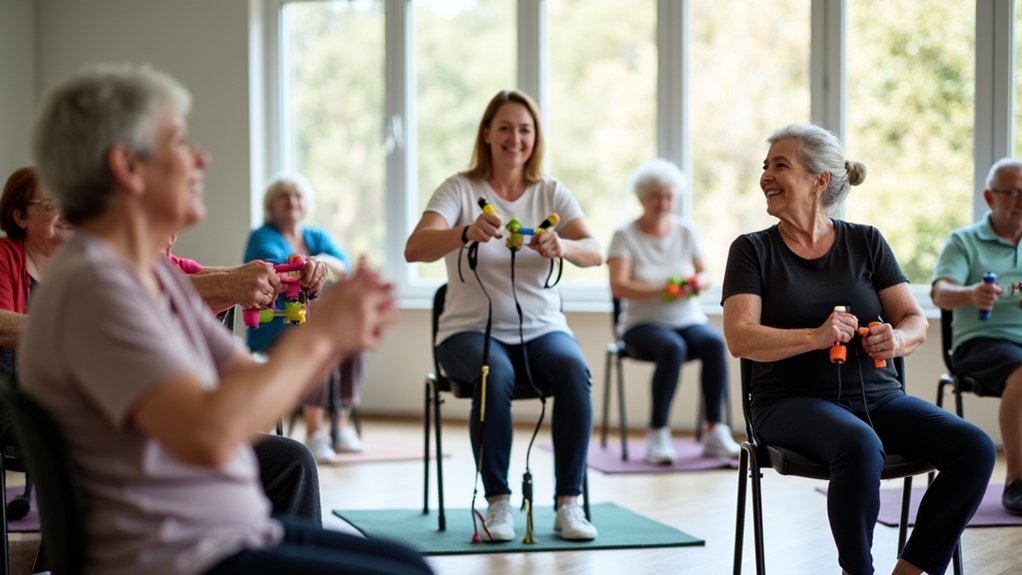Jump workouts reduce hunger cravings through multiple mechanisms. The vertical movement disrupts your gut function and suppresses ghrelin (your hunger hormone) while increasing peptide YY (a fullness hormone). Your body temperature rises during jumping, activating POMC neurons that signal decreased appetite, similar to eating spicy foods. These effects can last 15 minutes to two hours post-exercise, with men experiencing stronger hunger suppression than with cycling. The science behind this appetite control gets even more fascinating.
The Japanese Study: How Jump Rope Affects Hunger

While many fitness enthusiasts focus on calories burned during exercise, a groundbreaking Japanese study reveals that jumping rope might offer additional weight management benefits through appetite suppression.
Researchers discovered that men who jumped rope experienced markedly reduced hunger levels compared to those who cycled, with effects lasting about 15 minutes after exercise.
Jumping rope may temporarily suppress hunger more effectively than cycling, offering a dual exercise-appetite control benefit.
What makes jumping rope particularly effective? The study found that the intense gut disturbance and fatigue associated with jumping creates stronger appetite-suppressing effects.
Participants not only reported feeling less hungry during their jump sessions but also showed decreased cravings specifically for fatty foods.
The research identified positive changes in key appetite-regulating hormones like ghrelin and peptide YY, with jumping rope producing more pronounced effects than cycling.
Understanding the Science of Appetite Suppression
When you jump rope, your body triggers a complex hormonal cascade that actively suppresses hunger signals.
Your ghrelin levels—the hormone responsible for stimulating appetite—decrease while peptide YY increases, creating a temporary feeling of fullness that can last about 15 minutes after your workout.
This appetite-suppressing effect is enhanced by the activation of POMC neurons in your hypothalamus, which respond to your elevated body temperature during the jumping exercise.
Understanding the Science of Appetite Suppression
Although the relationship between exercise and hunger seems straightforward, jump rope workouts create a fascinating paradox in the body’s appetite regulation system.
When you’re jumping, your body temperature rises, signaling your brain to temporarily suppress hunger cravings.
Research shows this aerobic exercise specifically influences appetite-regulating hormones like ghrelin and peptide YY more effectively than other activities such as cycling.
These hormonal shifts reduce hunger sensations both during and immediately after your workout.
The physical intensity of jump rope exercises also contributes to appetite suppression.
Your body associates the temporary discomfort of jumping with decreased food desire, contradicting the conventional wisdom that physical activity always increases hunger.
This reveals how strategic exercise choices can help manage appetite, making jump rope a valuable tool for those monitoring their caloric intake.
Hormonal Response Mechanisms
Since jumping rope stimulates your endocrine system in unique ways, it creates a cascade of hormonal changes that directly impact your hunger signals. The jumping motion triggers a significant decrease in ghrelin (your hunger hormone) while simultaneously boosting peptide YY, which tells your brain you’re satisfied.
| Hormone | Effect | Duration |
|---|---|---|
| Ghrelin | Decreases | Up to 2 hours |
| Peptide YY | Increases | Post-exercise |
| POMC neurons | Activated | During activity |
| Appetite signals | Suppressed | 1-2 hours after |
This exercise-induced increase in body temperature activates POMC neurons in your hypothalamus—the same neurons stimulated by capsaicin in chili peppers. Your body’s hormonal response to jumping provides stronger appetite suppression than moderate exercises like cycling, specifically reducing cravings for fatty foods.
Impact on Ghrelin Levels
Jumping rope markedly alters your ghrelin levels, the primary hormone responsible for triggering hunger sensations in your brain.
When you engage in jump workouts, your body experiences a unique suppression of this hunger hormone that can last for approximately two hours afterward.
While studies show that ghrelin levels weren’t markedly different between jumping and cycling, the overall appetite suppression effect was much stronger with jumping rope.
- The jumping motion creates physical discomfort that naturally reduces your desire to eat
- Ghrelin suppression specifically targets cravings for fatty foods
- Men experience more pronounced hunger reduction from jumping compared to cycling
- Appetite suppression persists for about two hours post-exercise
- The physical fatigue from jumping contributes to lower ghrelin signaling
Vertical Movement and Gut Disturbance Theory
When your body experiences repetitive vertical motion during exercise, it appears to trigger unique physiological responses that affect hunger.
Research from Japan reveals that jumping rope creates greater gut disturbance than non-vertical exercises like cycling, directly influencing your appetite regulation.
The vertical movement of jumping disrupts normal gastrointestinal function, making eating feel uncomfortable. This jumping motion creates a distinct physiological response that suppresses hunger more effectively than other cardiovascular activities.
You’ll likely experience lower hunger levels for approximately 15 minutes after jumping rope, as your body processes the gut disturbance caused by the repetitive up-and-down motion.
Unlike cycling, the continuous vertical momentum of jumping workouts creates a temporary appetite suppression effect that might help you manage cravings in the short term.
Heat Response: Why Body Temperature Matters

Your body’s rising temperature during jump workouts triggers a natural appetite-suppressing effect similar to eating spicy foods containing capsaicin.
This thermogenic response activates POMC neurons in your hypothalamus, fundamentally sending “stop eating” signals to your brain when your core temperature increases.
As you sweat through plyometric exercises, you’re not just burning calories through movement—you’re activating metabolic pathways that naturally reduce hunger cravings for hours afterward.
Thermogenic Appetite Control
The heat generated during intense jumping workouts does more than just make you sweat—it actively influences how hungry you feel afterward. As your body temperature rises during rope jumping, POMC neurons in your hypothalamus activate, triggering natural appetite suppression.
This thermogenic response mimics what happens when you consume spicy foods containing capsaicin, creating a powerful hunger-controlling effect.
- Your jumping workout raises core temperature, signaling your brain to reduce appetite
- Research shows exercising mice eat 50% less than their sedentary counterparts
- The hypothalamus interprets increased body heat as a signal to suppress hunger
- Thermogenic exercise creates similar appetite control effects as spicy foods
- Your post-workout reduced hunger isn’t just psychological—it’s a biological response to heat
Core Heat Activation
Every degree of temperature rise during your jump workout triggers a cascade of appetite-regulating signals throughout your body. The rhythmic jumping motion activates your core muscles, generating internal heat that stimulates POMC neurons in your hypothalamus. These neurons directly influence appetite suppression when your body temperature increases.
| Heat Response | Appetite Effect | Metabolic Benefit |
|---|---|---|
| Core warming | Reduced hunger signals | Enhanced calorie deficit |
| POMC activation | Decreased food cravings | Improved satiety |
| Thermoreceptor stimulation | Hormonal appetite control | Extended post-workout suppression |
| Neural pathway engagement | Diminished snacking urges | Metabolic rate increase |
Your body responds to this heat similarly to consuming spicy foods—both activate sensory receptors that tell your brain you’re satisfied. This thermogenic response helps maintain your calorie deficit by naturally reducing hunger after intense jump sessions.
Metabolic Sweat Response
During high-intensity jump workouts, metabolic heat surges through your body, triggering a sophisticated sweat response that does more than just cool you down—it actively influences hunger regulation. This temperature increase activates POMC neurons in your hypothalamus, powerfully suppressing appetite post-exercise.
- Your elevated body temperature during jumping can reduce food intake by up to 50%, similar to effects observed in research studies.
- Capsaicin in spicy foods mimics exercise’s temperature-raising effect, confirming the heat-hunger connection.
- TRPV1 receptors act as thermal sensors, mediating the relationship between your metabolic sweat response and appetite control.
- When you jump rope, the resulting thermal reaction isn’t just a byproduct—it’s a biological signal for hunger reduction.
- Without proper heat activation during exercise, you’ll miss the appetite-suppressing benefits that make workouts effective for weight management.
POMC Neurons: The Brain’s Hunger Switch

Deep within your hypothalamus lies a remarkable neural system that controls your appetite.
Called POMC neurons, these specialized cells in your arcuate nucleus serve as your body’s natural hunger regulators. When activated, they trigger appetite suppression that can notably reduce your cravings.
Your body’s natural hunger control center—POMC neurons activate to turn down cravings when you need it most.
During your jump workouts, your rising body temperature naturally stimulates these POMC neurons. It’s a similar mechanism to how capsaicin from spicy foods reduces hunger signals.
Research shows this connection is powerful—mice exercising on treadmills ate about 50% less than their sedentary counterparts due to this neural activation.
This mechanism relies on TRPV1 receptors, which respond to both heat and capsaicin.
Block these receptors, and both exercise and spicy foods lose their appetite-suppressing effects—proving that POMC neurons truly function as your brain’s hunger switch.
Comparing Jump Workouts to Traditional Cardio
When you jump rope, the vertical impact triggers unique physiological responses that cycling can’t match, resulting in considerably reduced hunger levels.
This difference stems from distinct hormonal changes, as jumping workouts create more muscle fatigue and elevated body temperature than traditional cardio options.
Your body responds differently to the intense, multi-muscle engagement of jumping, which explains why you’ll experience fewer food cravings for up to 15 minutes after finishing your jump workout.
Vertical Impact Matters
Unlike traditional cardio exercises that keep you moving horizontally, jump workouts create considerable vertical impact that affects your hunger levels in surprising ways.
When you jump rope, each landing sends forces through your body that trigger appetite suppression mechanisms that cycling simply can’t match. Research shows this vertical impact can reduce your cravings for up to two hours after your workout, while cycling might actually increase your hunger.
- Your body produces more appetite-regulating hormones during vertical movement exercises
- Jump rope workouts suppress hunger considerably longer than cycling (up to 2 hours)
- The gut disturbance from landing impacts naturally reduces your desire to eat
- Multiple muscle group engagement contributes to post-workout fatigue that diminishes hunger
- The discomfort from jumping creates a natural deterrent against immediate post-exercise eating
Different Hormonal Responses
The hormonal changes triggered by jump workouts explain why your cravings diminish so greatly after jumping rope.
When you jump, your body produces less ghrelin (the hunger hormone) while simultaneously increasing peptide YY, which promotes feelings of fullness. This hormonal response is markedly different from what happens during traditional cardio like cycling.
The unique jumping motion creates greater gut disturbance than steady-state exercises, contributing to appetite suppression that lasts about 15 minutes post-workout.
Your body temperature also rises considerably during high-intensity jumping, sending signals to your brain that reduce hunger—similar to how spicy foods affect appetite.
These distinct hormonal responses help explain why you’ll experience fewer cravings for fatty foods after jumping rope compared to cycling, which often increases hunger instead of suppressing it.
Timing Your Jump Sessions for Maximum Appetite Control
Strategic timing of your jump rope workouts can greatly influence how effectively you control hunger cravings throughout the day.
If you’ve just completed a 12-hour fast, jumping rope can maximize appetite suppression effects, with benefits lasting up to two hours after your session. Consider scheduling your jump workouts right before meals to leverage this natural hunger control mechanism.
- Morning sessions provide all-day craving control, especially for fatty foods
- Post-fasting jumps enhance the appetite suppression effect
- Consistent daily timing helps regulate your hunger patterns
- Pre-meal jumping improves portion control and food choices
- The appetite-reducing benefits last approximately 15 minutes during and up to 2 hours after your workout
Rebounding Benefits Beyond Hunger Management
While timing your jump rope sessions effectively helps control hunger, jumping’s benefits extend far beyond appetite management.
The rhythmic jumping motion strengthens multiple muscle groups simultaneously, improving your coordination and stability with each bounce. You’ll notice enhanced cardiovascular fitness from these high-intensity workouts, which contribute to long-term weight management.
The exercise influences hormone levels in your body, supporting natural appetite regulation while boosting your metabolism.
What makes jump rope particularly valuable is its accessibility. You can perform this exercise almost anywhere with minimal equipment, making it easier to maintain consistency in your fitness routine.
As you incorporate regular jumping sessions, you’ll develop increased agility and balance that benefit your everyday movements, creating a thorough fitness approach that addresses both physical performance and nutritional behavior.
Implementing Jump Workouts in Your Weight Loss Strategy
When incorporating jump workouts into your weight loss strategy, you’ll want to leverage their unique hunger-suppressing benefits for maximum results. Jump rope exercises create a 15-minute window of appetite suppression post-workout, giving you an edge in managing caloric intake throughout the day.
Jump rope sessions create a powerful 15-minute appetite control window, naturally helping you manage calories for effective weight loss.
- Schedule jump sessions before meals to naturally reduce portion sizes through hunger suppression.
- Start with 2-3 minute intervals, gradually building to 10-minute sessions for ideal weight loss impact.
- Pair jump rope workouts with healthy eating to maximize the reduced cravings for fatty foods.
- Choose a proper surface with slight give to protect your joints while maintaining intensity.
- Implement jump workouts 3-4 times weekly to maintain consistent cravings control and steady weight loss.
Expert Recommendations for Jump Intensity and Duration
Fitness professionals have fine-tuned jump workout parameters to maximize hunger suppression while preventing workout fatigue. They suggest starting with brief sessions, then gradually increasing your intensity as your body adapts to the jumping motion.
Research supports dividing your routine into three 10-minute sets for ideal appetite suppression. This structure provides effective hunger control without overwhelming your system.
Maintaining proper form is essential—not only for injury prevention but also for enhancing workout efficiency.
To keep your routine engaging, incorporate various jumping styles like single-leg jumps or double unders. These variations challenge different muscle groups while sustaining the appetite-controlling benefits.
Don’t overlook rope length—using the correct size improves your technique and guarantees you’re getting the full hunger-suppressing advantage from each session’s duration.
The Long-Term Effects of Jumping on Appetite Regulation
Beyond the immediate post-workout effects, consistent jump rope exercise creates lasting changes in your body’s hunger regulation system. The repetitive jumping motion triggers hormonal responses that can reshape your appetite patterns over time.
When you make jumping a regular habit, you’re not just burning calories—you’re retraining your body’s hunger signals.
- Your body adapts by optimizing ghrelin and peptide YY levels, key hormones involved in appetite regulation.
- Regular high-intensity jumping sessions become a natural appetite suppressant.
- Your cravings for fatty foods specifically decrease as your body adjusts.
- The physical sensation associated with jumping helps diminish hunger for approximately two hours.
- Long-term jumpers develop more stable hunger patterns and improved control over cravings.
Frequently Asked Questions
Why Does Exercise Reduce Hunger?
Exercise reduces hunger by altering your body’s appetite-regulating hormones like ghrelin and peptide YY. You’ll also experience temporary appetite suppression from physical discomfort, increased body temperature, and activated POMC neurons in your hypothalamus.
Why Do I Have Less Cravings When I Workout?
You’ll experience fewer cravings when you workout because exercise alters your hunger hormones, raises body temperature, and creates fatigue. These physical responses temporarily suppress your appetite, especially after high-intensity activities like jumping rope.
Does Jump Rope Make You Hungry?
Jump rope actually suppresses your hunger. You’ll experience reduced cravings for about 15 minutes after jumping, especially for fatty foods. The high-intensity effort affects hunger hormones and the physical discomfort naturally curbs your appetite.
Does Exercise Help With Food Cravings?
Yes, exercise helps manage your food cravings. It suppresses hunger by altering hormone levels, creates physical discomfort that reduces appetite, and decreases your desire for fatty foods—effects that can last even after you’ve finished working out.
In Summary
You’ve now discovered why jumping workouts can help tame those hunger pangs. By triggering POMC neurons, creating mild gut disturbance, and raising your body temperature, these vertical movements offer unique appetite control benefits. Whether you’re using a jump rope or rebounder, you’ll find that consistent sessions not only burn calories but actually reduce your desire to eat. It’s a powerful tool for your weight management arsenal.





Leave a Reply